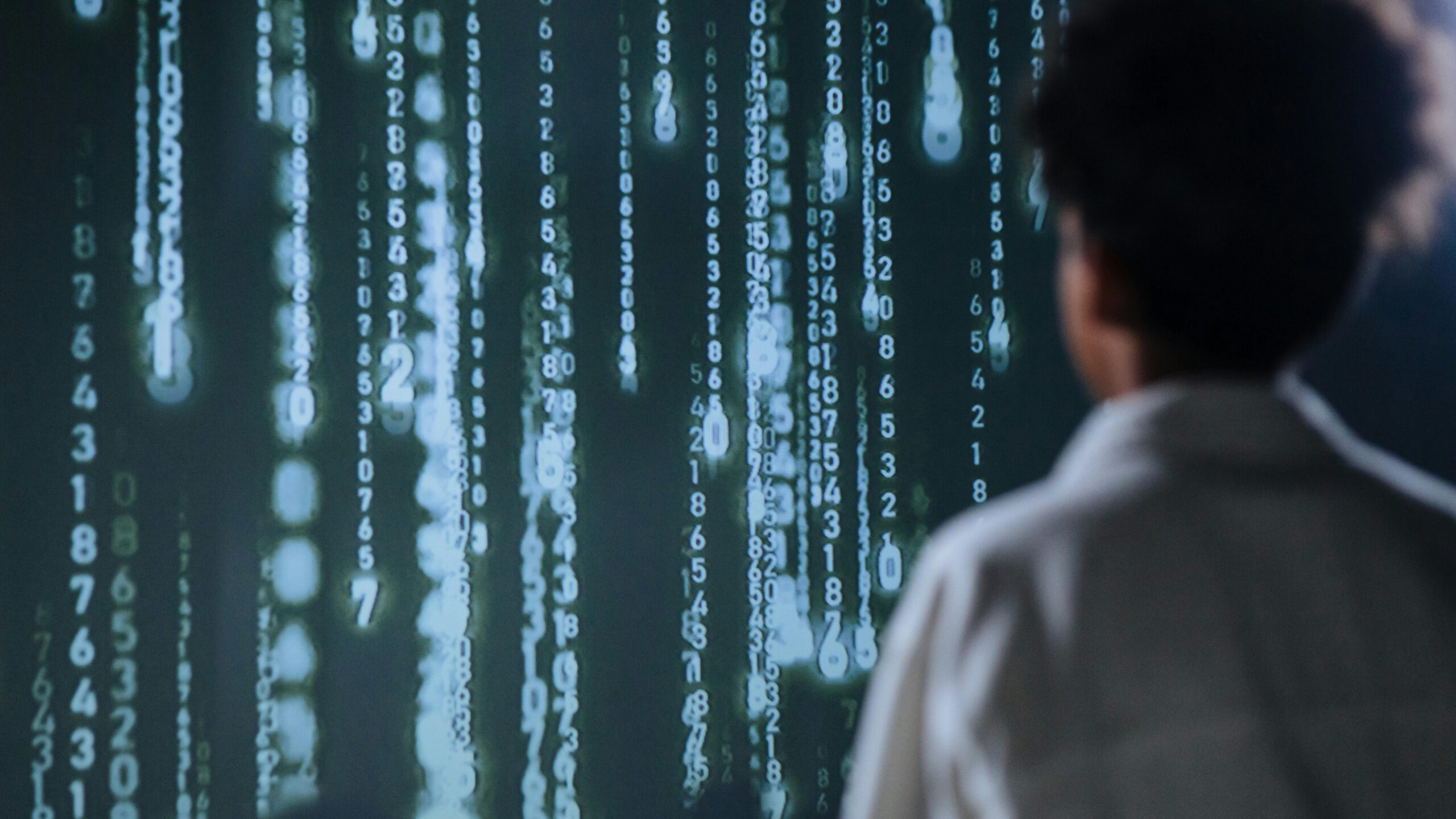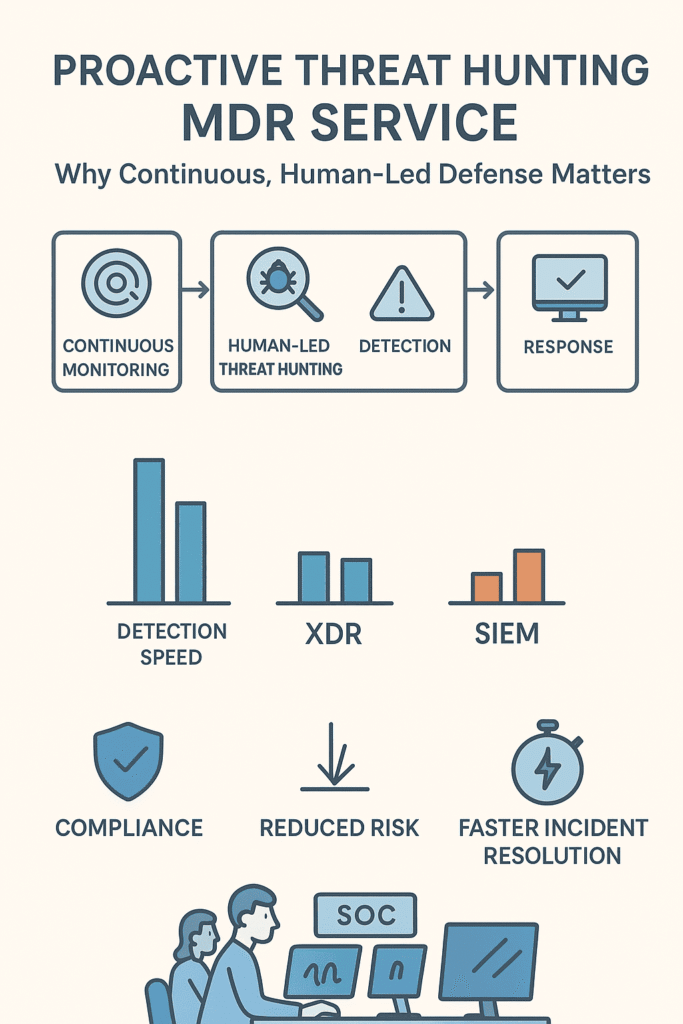Address
304 North Cardinal St.
Dorchester Center, MA 02124
Work Hours
Monday to Friday: 7AM - 7PM
Weekend: 10AM - 5PM
Address
304 North Cardinal St.
Dorchester Center, MA 02124
Work Hours
Monday to Friday: 7AM - 7PM
Weekend: 10AM - 5PM

Cyber threats rarely announce themselves with a warning. From what we’ve seen firsthand managing cybersecurity operations, the most dangerous attacks slip past automated alerts. That’s where proactive threat hunting within a Managed Detection and Response (MDR) service proves its worth.
It’s not enough to wait for an alert; you have to dig in, search actively, and find the stealthy adversaries hiding in your systems. This article breaks down how MDR services combine technology and expert analysts to hunt threats relentlessly, detect them early, and respond fast enough to stop damage.

The world of managed detection and response (MDR) isn’t as complicated as some make it sound. At its heart, it’s about having sharp,eyed experts watching your digital backyard 24/7.
They’re not just staring at screens waiting for red lights , they’re actively poking around in the dark corners where trouble likes to hide.
Gartner predicts that 50% of all enterprises will have adopted MDR services by 2025, underlining MDR’s rapid acceptance in cybersecurity strategies (1).
Think of MDR as your round the clock digital security team, but without the hassle of building one from scratch. These folks keep their eyes on everything from individual computers to entire networks and cloud systems.
They’re looking for anything that doesn’t quite fit the normal pattern (and trust me, they know what normal looks like).
Instead of trying to build their own security operations center (which costs a fortune and takes forever), companies can basically rent one.
The MDR team works remotely, using their expertise to handle all the security heavy lifting. It’s like having a SWAT team on speed dial, but for cyber threats. Tech Behind the Scenes
The tools these teams use aren’t magic , they’re actually pretty straightforward:
Here’s where things get interesting. Most security tools just sit there waiting for something bad to happen. But MDR teams? They’re out there actively looking for trouble. It’s the difference between waiting for smoke alarms to go off and actually checking every room for fire hazards.
These hunters don’t just randomly search, they follow leads based on what they know about how attackers operate. They’re familiar with all the usual tricks (mapped out in frameworks like MITRE ATT&CK), plus they keep up with new ones that pop up.
The big difference between active hunting and just watching alerts is pretty clear: one tries to catch problems before they become disasters, while the other just tells you when something’s already gone wrong. It’s like having someone actually patrol your neighborhood instead of just installing security cameras.

Credit: pexels.com (Photo by Christina Morillo)
The best MDR platforms don’t put all their eggs in one basket. They’re running multiple detection methods at once , checking for known malware signatures (think digital fingerprints).
Watching for weird behavior patterns, and catching anything that looks off compared to normal network traffic. When one method misses something, another usually catches it.
These systems are basically information vacuum cleaners. They’re pulling data from everywhere that matters:
It’s like having security cameras covering every angle of a building , you don’t want any blind spots where the bad guys can hide.
When it’s working right, MDR spots both the usual suspects (known malware) and the new tricks that attackers come up with. The faster you catch them, the less damage they can do. Pretty straightforward.
Once MDR confirms there’s actually a threat (and not just a false alarm), it’s time to act. The response usually goes like this:
Speed matters here , like, really matters. Every minute counts when there’s malware loose in your network.
The smart MDR setups let computers handle the obvious stuff (like quarantining a clearly infected computer), while the human analysts tackle the tough decisions. Think of it like a hospital , nurses handle routine care while doctors focus on the complex cases.
Most MDR providers promise they’ll respond within minutes or hours when they spot something bad. From what we’ve seen in real attacks, that quick reaction time can mean the difference between a minor incident and a major breach.
There’s something fascinating about watching cyber threats unfold in real time, like a digital game of cat and mouse. MDR’s not just another security tool, it’s changing how businesses fight back.
Threat hunting yields real security improvements: a 2019 SANS Institute survey found that 61% of respondents reported at least an 11% measurable improvement in overall security posture, while 23.6% noted significant reductions in dwell time (2).
The numbers don’t lie. When security teams cut down detection time from days to hours (sometimes even minutes), attackers don’t stand a chance. This is one of the key MDR benefits, stopping intruders early, like catching someone trying to pick your lock before they even get the tools out.
Nobody likes paperwork, but MDR handles the grunt work. It spits out detailed logs and reports that keep auditors happy and prove you’re following the rules. It’s pretty much a digital paper trail that shows exactly who did what and when.
Pay for what you need, grow when you want. Most providers offer monthly subscriptions that won’t break the bank, starting around $10 per endpoint. Perfect for companies that don’t want to drop six figures on security right away.
Instead of sitting back and waiting for alarms, MDR teams are always on the hunt. They’re poking around in dark corners, checking for anything suspicious, and actually finding the sneaky stuff before it becomes a problem.
It’s like having a worldwide network of informants. MDR pulls in real,world threat data from everywhere, mixes it with what’s happening on your network, and figures out what’s actually dangerous versus what’s just noise.
The bottom line? Bad guys get caught faster, nothing sneaks by unnoticed, and companies actually stand a chance against the sophisticated attacks that keep getting worse every year. Plus, security teams finally get some sleep at night.
Security teams can’t seem to keep up with all these three,letter solutions. Here’s what actually matters when picking between them.
XDR’s pretty straightforward, it’s software that pulls data from everywhere (computers, networks, cloud stuff). But to really grasp what is MDR you need to see how it takes that same tech and adds real people watching your back 24/7. Think of XDR as the car, and MDR as the car with a professional driver.
SIEM’s just collecting logs and throwing alerts at you all day. MDR goes further , actual analysts look at those alerts and jump in to fix problems. No more alert fatigue.
If you don’t have your own security team (and let’s face it, most companies don’t), MDR’s probably your best bet. Someone else handles the whole security headache for you.
There’s a method to madness when it comes to hunting threats.
MDR pulls in everything , what’s happening on computers, network traffic, system logs, plus intel about new threats. More data means fewer blind spots.
Hunters don’t just randomly look around. They track patterns, like when someone’s moving between computers in weird ways at 3 AM.
It’s part machine, part human skill. Analysts dig through suspicious files, connections, and user activity until they find what doesn’t belong.
Every hunt makes the system smarter. Find something new? Update the rules.
These folks never sleep. They’re watching, hunting, and jumping on problems 24/7.
You can’t replace experience. These analysts have seen it all and know exactly where to look when something’s off.
Their value also connects to different MDR service levels, from basic monitoring to advanced response, each level benefits from skilled SOC teams who know where to focus.
They’re not working in a bubble , there’s constant back, and forth with customer teams to keep everyone in the loop.
Extended Focus Areas and Emerging Trends in MDR Proactive Threat Hunting
The game’s changing. Now they’re watching cloud systems and identity stuff too , that’s where the bad guys are heading.
Robots help speed things up, but they’re not taking over. Some things still need a human touch.
AI helps spot weird stuff faster, but it’s just helping the analysts, not replacing them.
They’re always updating their playbook as attackers try new tricks.
Looking for hidden threats isn’t exactly glamorous work , it’s more like finding needles in digital haystacks. But when your company’s data is on the line, having experts actively hunting for trouble beats waiting for alarms to go off.
For companies who don’t want to build their own security team (and deal with that headache), MDR’s the way to go. Just something to think about.
The big lesson is that Managed Detection and Response works best when people and smart tools team up. Computers can spot patterns fast, but skilled hunters know where to look for sneaky threats that hide from alerts.
By finding and stopping attacks early, MDR keeps companies safer, cuts down on damage, and saves teams from long nights worrying.
Learn more about our expert MDR and MSSP consulting services to build the right tools, improve integration, and boost your security.
Proactive threat hunting in an MDR service uncovers hidden risks early. Managed detection and response combines human expertise with tools like EDR solutions and XDR to boost cybersecurity threat detection and stop attacks quickly.
A security operations center manages SOC monitoring, intrusion detection, and incident response. Analysts use threat intelligence, anomaly detection, and network security monitoring to detect threats, often with support from an MSSP.
SOC analysts handle incident containment and attack surface monitoring. They use vulnerability hunting, threat triage, and response automation to block threats and improve cyberattack prevention.
SIEM integration enables log correlation, improving machine learning threat detection and alert management. It supports MDR risk assessment, malware hunting, and lateral movement detection.
A threat hunting workflow applies threat detection intelligence, adversary hunting, and automated threat hunting to disrupt attack chains, enhance cybersecurity resilience, and stop zero-day threats.